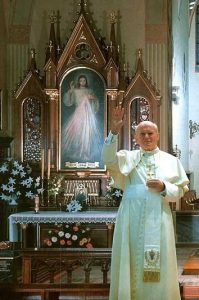Ave Maria Meditations
 Sister Faustina heard these words as she prayed for Poland; “I bear a special love for Poland, and if she will be obedient to My will, I will exalt her in might and holiness. From her will come forth the spark that will prepare the world for My final coming.” Diary of St Faustina: Notebook VI 1732
Sister Faustina heard these words as she prayed for Poland; “I bear a special love for Poland, and if she will be obedient to My will, I will exalt her in might and holiness. From her will come forth the spark that will prepare the world for My final coming.” Diary of St Faustina: Notebook VI 1732
St. Faustina and John Paul II:
The foremost champion of the Divine Mercy message in our day has been St. Pope John Paul II. Not only was he instrumental in having the ban on the spread of the message lifted, but he made Divine Mercy the theme of the second encyclical of his pontificate, “Dives in Misericordia”.
During his visit to Faustina’s tomb on June 7, 1997, he even stated that Divine Mercy has “formed the image of his pontificate.” Mere months before being named pope, Cardinal Karol Wojtyla of Krakow, Poland, after years of exhaustive work, succeeded in having the ban on Faustina’s writings lifted. Since that time, this pope promoted Divine Mercy and championed the cause of St. Faustina and her writings. He came to be known as “The Mercy Pope.”
The Great Mercy Pope:
Pope John Paul II wrote: “The Message of Divine Mercy has always been near and dear to me… which I took with me to the See of Peter and which it in a sense forms the image of this Pontificate.”
In his writings and homilies, he described Divine Mercy as the answer to the world’s problems and the message of the third millennium. He beatified and canonized Sr. Maria Faustina Kowalska, the nun associated with the message, and he did it in Rome and not in Poland to underscore that Divine Mercy is for the whole world. When he canonized St. Faustina, he also established the Feast of the Divine Mercy, just as Our Lord had asked, on the second Sunday after Easter and he granted to it all the indulgences granted by Our Lord.
It was no coincidence that Saint John Paul II, died during the Vigil of Divine Mercy Sunday. It was totally apropos.
